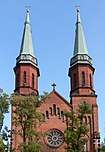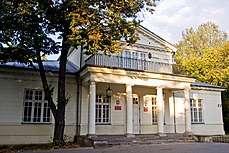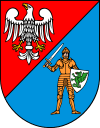Pruszków
Pruszków [ˈpruʂkuf] (![]()
Pruszków | |
|---|---|
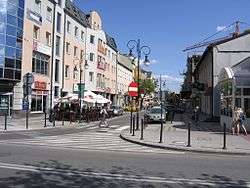 Central part of town | |
 Flag 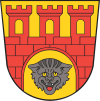 Coat of arms | |
| Motto(s): Kolej na Pruszków! It's Pruszków's turn! | |
 Pruszków  Pruszków | |
| Coordinates: 52°10′N 20°48′E Country | |
| Voivodeship | |
| County | Pruszków County |
| Gmina | Pruszków (urban gmina) |
| Established | 16th century |
| Town rights | 1916 |
| Government | |
| • Mayor | Paweł Makuch |
| Area | |
| • Total | 19.15 km2 (7.39 sq mi) |
| Population (2014) | |
| • Total | 60,068 |
| • Density | 3,100/km2 (8,100/sq mi) |
| Time zone | UTC+1 (CET) |
| • Summer (DST) | UTC+2 (CEST) |
| Postal code | 05-800, 05-802, 05-803, 05-804 |
| Area code(s) | +48 22 |
| Car plates | WPR |
| Website | http://www.pruszkow.pl/ |
History
Pruszków was incorporated as a town in 1916 during World War I, although a village has existed there since the 16th century. The development of the town was aided by the construction of the Warsaw-Vienna Railway in the 19th century and the construction of the Elektryczna Kolej Dojazdowa (now Warszawska Kolej Dojazdowa), Poland's first electrified commuter train line, in 1927. A large psychiatric hospital opened in the outlying village of Tworki in 1891 and is still operating to this day.[3] During the World War I, a battle between German and Russian forces took place in Pruszków on 12–18 October 1914 (part of Battle of the Vistula River). Despite the initial success of the German forces on 12 October, they were push-backed out of town after successful Russian counter-attack on 14th. An intense artillery fire by both sides caused severe damages to many buildings in Pruszków including train station, power plant, and two churches. In August 1915 Pruszków was taken by the German forces without a fight.
World War II
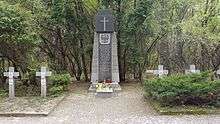
The city had a large Jewish population before the Nazi–Soviet Invasion of Poland. In 1940, the German occupation authorities established a Jewish ghetto in Pruszków, in order to confine its Jewish population for the purpose of persecution and exploitation.[4] The ghetto was liquidated on January 31, 1941, when all its 1,400[5]–3,000 inhabitants were transported in cattle trucks to Warsaw Ghetto, the largest ghetto in all of Nazi occupied Europe with over 400,000 Jews crammed into an area of 1.3 square miles (3.4 km2). From there, most victims were sent to Treblinka extermination camp.[6][7][8][9]

During the 1944 Warsaw Uprising, the Nazis created a large transit camp (Durchgangslager) in Pruszków on the site of the Train Repair Shops (Zakłady Naprawcze Taboru Kolejowego) to intern the evacuees expelled from the capital. Around 550,000 Warsaw residents and approximately 100,000 more from its outskirts were incarcerated in the Durchgangslager 121 (Dulag 121) set up for this purpose. The SS and Gestapo segregated the victims before transport. Approximately 650,000 Poles passed through the Pruszków camp in August, September and October 1944. Approximately 55,000 were sent to concentration camps, including 13,000 to Auschwitz. They included people from a variety of social classes and occupations (government officials, scholars, artists, physicians, merchants, and blue-collar workers), in varying physical conditions (the injured, the sick, invalids, and pregnant women), and of various ages from infants only a few weeks old to the elderly, aged 86 or more. In a few cases, these were also people of different ethnic backgrounds including Jews living on "Aryan papers."[10]
Following the Soviet westward offensive, on March 26, 1945, the 16 members of the Polish Underground Government were invited by the Russians for talks, to a house in Pruszków on Armii Krajowej Street. They were captured by the Soviet NKVD agents, transported to USSR, imprisoned, tortured and sentenced in Moscow during the so-called Trial of the Sixteen.
Post-war Poland
After World War II, Pruszków became one of Masovia's largest industrial centers. Due to its proximity to Warsaw, it is now home to several factories and companies, including Herbapol, Daewoo Electronics, L'Oréal Cosmetics as well as logistic centers. It is also an important sports center, with a sports gymnasium, soccer stadium and a cycling course.
Former Polish president Bronisław Komorowski spent part of his childhood in Pruszków.
Sports
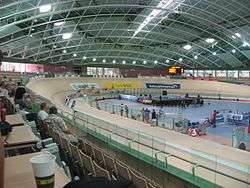
The city's local football team is Znicz Pruszków. It plays in the Polish Second League (third division), but in the past it competed in the Polish First League (second division) (2007-2010 and 2016-2017). Robert Lewandowski played in Znicz from 2006 to 2008. Pruszków-born Jacek Gmoch and Radosław Majewski also played in Znicz: Gmoch from 1953 to 1958, Majewski from 2002 to 2006.[11]
The BGŻ Arena indoor velodrome is located in Pruszków.
Tourism
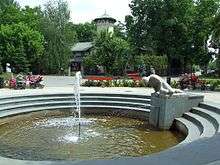
- The Museum of Ancient Mazovian Metallurgy
- Nineteenth century manor with landscaped gardens.
- Muzeum Dulag 121
Buildings and structures
256 metres tall chimney of former "Pruszków II Power Plant", now used as radio tower.
Education
- Physical Culture and Tourism High School (Wyższa Szkoła Kultury Fizycznej i Turystyki)
Notable people
- Leszek Cichy (b. 1951), mountaineer and high-altitude climber
- Jacek Gmoch (b. 1939), footballer and football manager
- Ałbena Grabowska (b. 1971), writer, neurologist
- Radosław Majewski (b. 1986), footballer
- Konrad Morawski (1913–1985), television and theatre actor
References
- http://stat.gov.pl/files/gfx/portalinformacyjny/pl/defaultaktualnosci/5515/3/9/1/rocznik_demograficzny_2015.pdf
- "Central Statistical Office (Poland), Ludność. Stan i struktura w przekroju terytorialnym" (PDF).
- Tworki is an administrative part of Pruszków today
- "The War Against The Jews." The Holocaust Chronicle, 2009. Chicago, Il. Accessed June 21, 2011.
- The statistical data compiled on the basis of "Glossary of 2,077 Jewish towns in Poland" Archived 8 February 2016 at the Wayback Machine by Virtual Shtetl Museum of the History of the Polish Jews (in English), as well as "Getta Żydowskie," by Gedeon, (in Polish) and "Ghetto List" by Michael Peters at www.deathcamps.org/occupation/ghettolist.htm (in English). Accessed July 12, 2011.
- Warsaw Ghetto, United States Holocaust Memorial Museum (USHMM), Washington, D.C.
- Richard C. Lukas, Out of the Inferno: Poles Remember the Holocaust, University Press of Kentucky 1989 - 201 pages. Page 13; also in Richard C. Lukas, The Forgotten Holocaust: The Poles Under German Occupation, 1939-1944, University Press of Kentucky, 1986, Google Print, p.13.
- Gunnar S. Paulsson, "The Rescue of Jews by Non-Jews in Nazi-Occupied Poland," Journal of Holocaust Education, Vol.7, Nos.1&2, 1998, pp.19-44. Published by Frank Cass, London.
- Edward Victor, "Ghettos and Other Jewish Communities." Archived 9 October 2019 at the Wayback Machine Judaica Philatelic. Accessed June 20, 2011.
- Księga Pamięci. Transporty Polaków z Warszawy do KL Auschwitz 1940-1944 (Memorial Book: Transports of Poles from Warsaw to Auschwitz Concentration Camp 1940-1944. Archived 26 August 2011 at the Wayback Machine Auschwitz-Birkenau Museum. On the Sixtieth Anniversary of the Warsaw Uprising. Accessed July 13, 2011.
- "Bajka o Robercie Lewandowskim". Sport.pl (in Polish). Retrieved 14 February 2016.
External links
| Wikimedia Commons has media related to Pruszków. |
- (in Polish) Pruszków official website
- (in Polish) Alleycat races in Pruszków
- (in English) Museum of Ancient Mazovian Metallurgy
- Jewish Community in Pruszków on Virtual Shtetl


